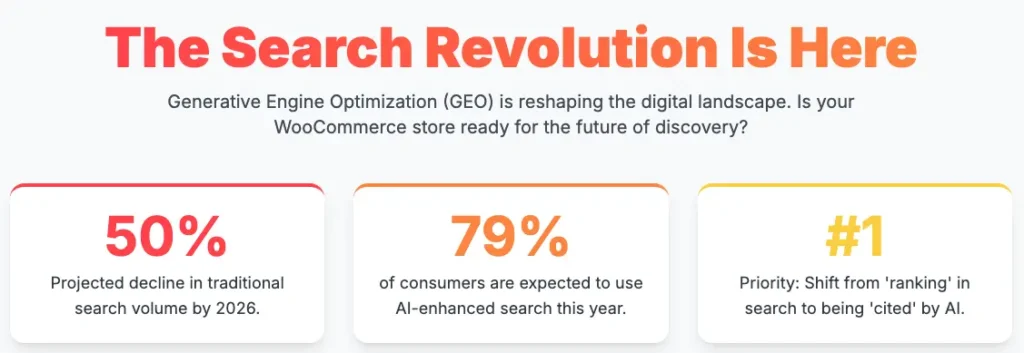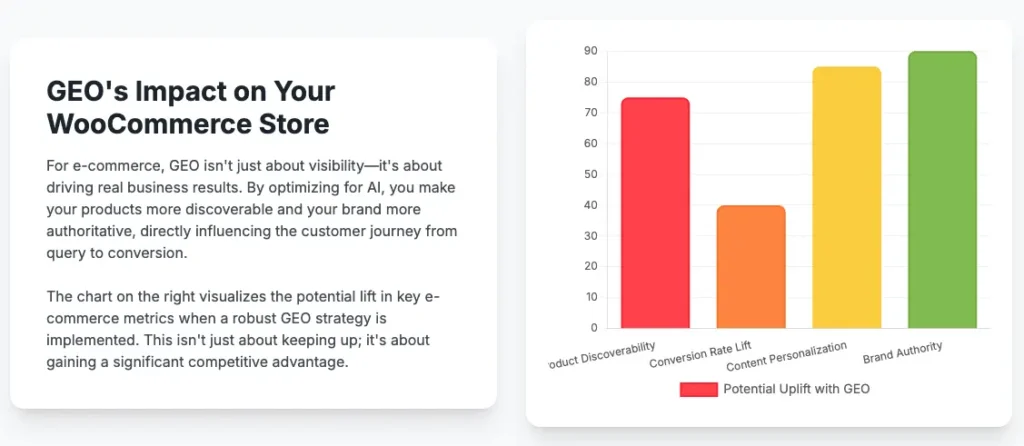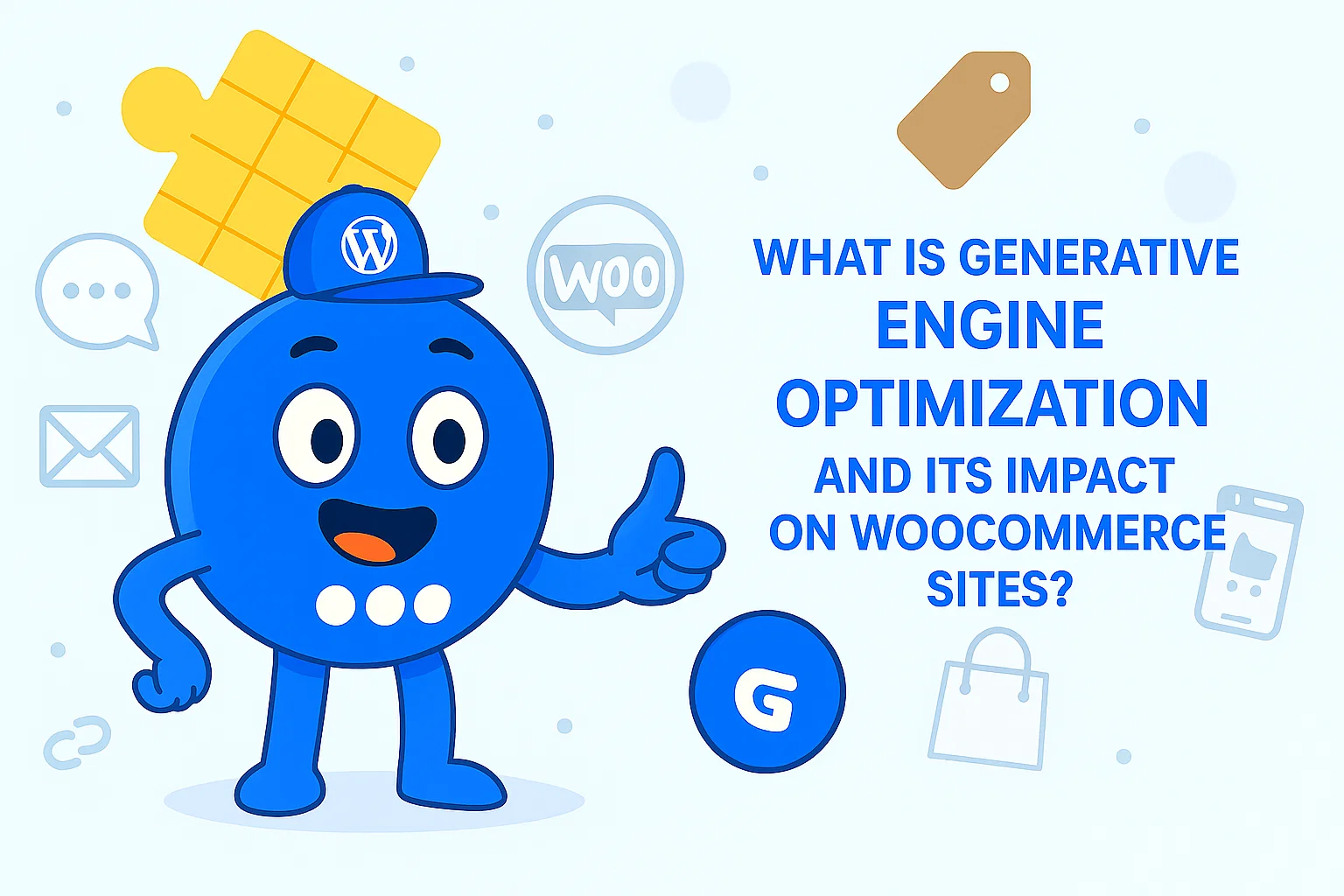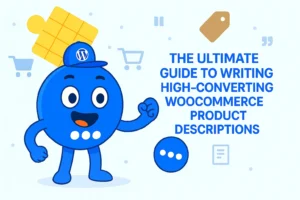What is Generative Engine Optimization and its Impact on WooCommerce Sites?
The digital marketing landscape is undergoing a profound transformation, driven by the rapid evolution of artificial intelligence (AI) and its integration into search mechanisms. Generative Engine Optimization (GEO) represents a crucial evolution in this domain, shifting the focus from traditional Search Engine Optimization (SEO) to optimizing content specifically for AI-driven generative models such as ChatGPT, Gemini, and Google’s AI Overviews. This transition is becoming indispensable as consumer search behavior increasingly leans towards conversational AI interactions rather than conventional link lists.

For e-commerce sites built on the WooCommerce platform, GEO is not merely an advantageous strategy but a strategic imperative. It directly influences product discoverability, ensures accurate brand representation in AI responses, and ultimately impacts conversion rates within an e-commerce landscape where AI-enhanced search is projected to become the dominant mode of information retrieval.
Effective GEO implementation involves a multi-faceted approach. This includes crafting content that is conversational and provides direct answers, rigorously building E-E-A-T (Experience, Expertise, Authoritativeness, Trustworthiness) signals, diversifying content formats with rich multimedia, leveraging AI for content generation, and strategically distributing content across AI-friendly online platforms.
To future-proof a digital presence and maximize visibility and engagement in the rapidly evolving AI-driven search environment, a balanced and integrated approach combining traditional SEO practices with proactive GEO strategies is absolutely essential.
1. The Dawn of Generative Engine Optimization (GEO)

1.1 What is Generative Engine Optimization (GEO)?
Generative Engine Optimization (GEO) is precisely defined as the systematic practice of optimizing a website’s content and its underlying technical structure to facilitate easier parsing and comprehension by Artificial Intelligence (AI) models.
The overarching objective of GEO is to significantly increase the probability of a website or its associated brand being accurately cited, referenced, or explicitly included in AI-driven search engine results and the comprehensive responses generated by AI systems. This burgeoning discipline is also known by several other appellations, including AI Search Optimization (ASO), Conversational Search Optimization (CSO), or Large Language Model Optimization (LLMO), each term underscoring its inherent focus on conversational AI and the capabilities of large language models (LLMs).
Fundamentally, GEO diverges from traditional SEO, which predominantly concentrates on keyword relevance and achieving higher rankings within a list of search results. Instead, GEO prioritizes ensuring that AI systems can grasp the broader context of the content, its intrinsic relationship to the brand, and multiple layers of detailed information. Its ultimate aim is to secure brand citations and accurate representation within AI outputs, even in scenarios where a user may not directly navigate to the website.
This represents a profound paradigm shift in how brand visibility, authority, and perceived value are measured. Historically, the ultimate metric of success in digital marketing has been the click-through rate (CTR) and the subsequent traffic driven to a website, with conversions being the final goal. However, the emphasis in GEO on brand citation by AI engines, even without an immediate site visit, indicates a fundamental re-evaluation of success.
If an AI system directly provides a comprehensive answer that prominently cites a brand, the user’s immediate informational need is met without the necessity of a direct website visit. This implies that brand recognition and the establishment of factual authority become paramount, potentially decoupling direct website traffic as the sole indicator of brand value in the emerging AI-driven search ecosystem.
This fundamental shift necessitates that businesses fundamentally re-evaluate and re-strategize their content creation approach. The focus must evolve from merely attracting clicks to becoming the definitive, most trustworthy, and easily digestible source that AI models will reliably reference. This mandates a stronger emphasis on factual accuracy, demonstrable authoritativeness, and the creation of clear, concise answers that can be effortlessly extracted, summarized, and attributed by an AI, moving beyond purely engaging prose designed solely for human readers.
1.2 How Generative AI Engines Work (LLMs, NLP, Contextual Understanding)

Generative AI models, predominantly Large Language Models (LLMs), undergo extensive training on colossal datasets encompassing books, scholarly articles, and a vast array of publicly available websites. This comprehensive training regimen enables them to discern and learn intricate patterns in grammar, contextual relationships, and tonal nuances, thereby empowering them to produce remarkably human-like responses and effectively synthesize complex information.
At the very core of these advanced engines lies Natural Language Processing (NLP). NLP capabilities allow these models to deeply understand the subtleties of user queries, including the underlying intent, the emotional tone, and the broader context, rather than simply matching keywords. This sophisticated understanding facilitates the delivery of more holistic, nuanced, and accurate answers. Crucially, these AI models possess the inherent capacity for continuous adaptation.
They remain current by actively tapping into ongoing user interactions, incorporating user feedback, integrating new data inputs, and analyzing traditional search engine results, allowing them to dynamically adapt to recent events, emerging trends, and freshly available information. This continuous learning mechanism underscores why content freshness and regular updates are a significant factor for effective GEO.
Several sources emphatically state that AI models respond more favorably to “simple, helpful language over marketing fluff or technical jargon” and that “people talk to AI models in the same way they talk to a knowledgeable friend”. This is not merely a suggestion for improved readability; it reveals a deeper understanding of the very nature of AI model training.
For e-commerce businesses, this means that product descriptions, comprehensive FAQs, and engaging blog posts should adopt the voice of a helpful, knowledgeable salesperson or a trusted friend explaining a product’s benefits, rather than a dry, feature-centric list. This directly impacts and necessitates a re-evaluation of a brand’s established voice and content guidelines to align with AI’s preferred communication style.
1.3 GEO vs. Traditional SEO: A Comparative Analysis
While both Search Engine Optimization (SEO) and Generative Engine Optimization (GEO) share the overarching objective of enhancing online visibility, their fundamental approaches, target platforms, and operational mechanisms differ significantly. The following table provides a concise comparison of these two critical digital marketing disciplines:
| Category | Traditional SEO | Generative Engine Optimization (GEO) |
|---|---|---|
| Objective | Improving website ranking on traditional search engines (e.g., Google, Bing) | Optimizing content for inclusion in AI-generated responses |
| Target Platform | Traditional search engine results pages (SERPs) | AI-driven generative models (e.g., ChatGPT, Gemini, Perplexity) |
| Content Goal | Driving direct traffic to the website through ranked results | Ensuring brand citation and accurate representation in AI answers |
| Primary Optimization Techniques | Keyword optimization, backlink building, meta tags, site structure | Contextual understanding, semantic optimization, conversational tone, structured data (schema), E-A-T signals |
| Content Display | List of ranked links | Summarized answers with cited sources |
| User Interaction | Users click individual links to access content | Users receive direct, synthesized answers, potentially reducing clicks |
| Key Performance Metrics | Website traffic, conversion rates, search engine rankings | Brand citations, share of voice in AI models, engagement with AI-generated content |
1.4 Why GEO is the Future of Search for Businesses
The digital information landscape is undergoing a rapid and profound transformation, with a decisive shift towards AI-driven search modalities. Projections indicate a substantial decrease in traditional search volume, anticipated to decline by over 50% by 2026, while simultaneously forecasting a massive surge in AI-enhanced search usage, with 79% of consumers expected to utilize it within the next year. This dramatic shift renders GEO not merely an advantageous option but an absolute critical strategy for businesses to maintain their online visibility and relevance.
Users are increasingly gravitating towards the natural language interaction and the direct, concisely summarized answers provided by generative AI tools. This preference stems from the inherent speed and convenience offered, which surpasses the traditional method of clicking through multiple web pages to find information. Furthermore, AI models offer the unique capability for iterative search and deeper, more contextual questioning, enhancing the user experience significantly.
The stark warning that “If your content isn’t optimized for these models, it risks becoming invisible” transcends a mere cautionary note; it highlights a profound and immediate competitive threat. In an AI-driven search environment, if a competitor’s content is consistently cited, summarized, and recommended by AI, while a brand’s content is not, that brand effectively loses mindshare and direct access to users precisely at the critical point of information seeking.
Businesses that proactively invest in and master GEO will not only secure their future visibility but also strategically establish themselves as authoritative, go-to sources within their niche. This proactive stance has the potential to significantly erode the market share and influence of competitors who are slow to adapt, making GEO not just about adapting to a new technology, but about gaining a decisive strategic lead and defending market position.
2. GEO’s Transformative Impact on WooCommerce Sites

2.1 Enhancing Product Discoverability in the AI Era
For e-commerce businesses, the strategic adoption of GEO can dramatically enhance product discoverability and significantly boost conversion rates by making their content intrinsically more appealing and comprehensible to AI-driven search engines. AI-driven search engines are designed to generate contextually rich and comprehensive answers.
This means that products and services from a WooCommerce site can be succinctly summarized and directly recommended within AI responses, thereby increasing visibility even without the traditional requirement of a direct click to the site. GEO plays a pivotal role in helping WooCommerce stores adapt to the evolving digital reality where users now expect direct, summarized answers and highly personalized experiences, moving beyond the simple list of links provided by traditional search.

2.2 Core Strategies for Optimizing WooCommerce Content for Generative AI:
2.2.1 Crafting Conversational and Direct-Answer Content
Generative AI models are primarily trained on and draw citations from natural, conversational language. Therefore, content must inherently reflect this tone, adopting a style that resembles a knowledgeable friend engaging in a helpful dialogue. It is crucial to prioritize simple, helpful language and deliberately avoid marketing fluff, overly technical jargon, or complex corporate phrasing. For instance, opting for straightforward phrasing like “helps teams save time” is far more effective than “leveraging cutting-edge methodologies to maximize operational efficiency”.
Content should be designed to directly answer user questions, present information in clear lists, and offer actionable advice, mirroring the directness of AI responses. To identify the most relevant questions, businesses should analyze real-world queries on platforms such as AnswerThePublic, Reddit, and Quora, and actively consult insights from their sales and customer service teams who are on the front lines of user concerns. The focus should shift towards long-tail keywords that accurately reflect user intent-based searches and semantic keywords that capture broader meaning, rather than relying solely on exact keyword matches.
2.2.2 Structuring Data for AI Accessibility (Headings, Lists, FAQs)
Optimizing page structure using clear, descriptive headings (H1-H3 tags), concise bullet points, and dedicated FAQ sections is vital. This structural clarity makes content easily digestible for both human readers and AI systems, improving its parseability. Concise introductions and the effective use of header tags further enhance search visibility and overall readability, making content more approachable for AI.
2.2.3 Building E-E-A-T (Experience, Expertise, Authoritativeness, Trustworthiness)
E-E-A-T (Experience, Expertise, Authoritativeness, and Trustworthiness) signals are critically important for GEO, as AI models are programmed to prioritize and cite credible, high-quality, and reliable sources in their responses. Content must consistently and demonstrably prove its credibility across all four pillars of E-E-A-T. This involves showcasing real-world experience, deep subject matter expertise, established authoritativeness in the field, and unwavering trustworthiness.
Assigning clear authors to content and creating dedicated, detailed author pages can significantly enhance credibility and signal expertise to AI models. Incorporating reputable external sources, direct quotes from experts, and appropriate industry-specific language, alongside writing in an authoritative yet accessible manner, collectively builds trust and reinforces expertise.
Developing a robust, industry-focused backlinking strategy and actively leveraging public relations efforts—such as obtaining bylines in reputable publications, securing placements, collaborating with influential figures, and issuing impactful press releases—are crucial for enhancing overall brand credibility and authority in the eyes of AI.
2.2.4 Leveraging AI Content Generation for Product Descriptions
AI content generation tools offer a powerful solution to automate the creation of high-quality product content. This includes not only detailed product descriptions and concise short descriptions but also compelling featured images and comprehensive gallery images. These sophisticated tools can generate content with a variety of tones—ranging from formal and professional to casual and friendly, persuasive and sales-focused, technical and detailed, luxury and premium, or creative and engaging—allowing businesses to perfectly match their brand voice and target audience.
Furthermore, AI can be utilized to optimize and refine existing SEO titles and descriptions for WooCommerce products. This ensures they are concise, highly engaging, and effectively keyword-optimized within character limits, improving both human appeal and AI parseability. Such tools can perform bulk generation or refinement of these crucial elements, streamlining content management.
2.2.5 Strategic Content Distribution Beyond Your Website
To maximize influence on AI models, it is essential to repurpose and strategically share content across diverse platforms from which these models learn. Key platforms include active online communities like Reddit and Quora, as well as professional networking sites such as LinkedIn. Actively engaging in discussions on niche forums and various social media platforms, where natural language is abundant and organic conversations occur, significantly increases the likelihood of insights being picked up, processed, and ultimately cited by generative AI tools. Leveraging user-generated content, such as customer reviews and social media posts, is also a powerful strategy, as these informal yet authentic data points contribute to the overall knowledge base that AI models consume.
2.3 Measuring GEO Effectiveness for E-commerce

Measuring the effectiveness of GEO involves a strategic shift in focus towards specific metrics that accurately reflect content performance and its alignment with the functionalities of AI-driven search.
Key Metrics for GEO Success:
- Brand Citations/Share of Voice: This is a primary GEO metric, quantifying how frequently a brand, its products, or services are accurately referenced and cited within AI-generated responses. Tools like AI Search Grader can be instrumental here, as they help evaluate brand visibility in platforms like ChatGPT by simulating relevant prompts and analyzing the frequency and position of brand appearances in AI outputs.
- Click-Through Rate (CTR): While GEO’s core aim is citation, a healthy CTR still serves as a strong indicator that when a link is provided by the AI, the content resonates effectively with generative search engines, prompting users to click for more detail.
- Engagement Metrics: Measures such as ‘time on page‘ and ‘social shares‘ are vital. High engagement signals to AI-driven search engines that content is valuable and relevant, thereby boosting its visibility and potential for citation.
- Bounce Rate: A lower bounce rate is a positive indicator, signifying that users find the content relevant and engaging after interacting with an AI-generated summary, suggesting the content is well-tailored to generative search queries.
- Organic Traffic: While not the sole metric, increased organic traffic still implies better alignment with generative search engines and improved overall search rankings, demonstrating a successful hybrid SEO+GEO strategy.
If GEO’s primary objective is to achieve brand citation within AI-generated responses, potentially without immediately driving direct website clicks , then traditional performance metrics that rely heavily on direct traffic and last-click conversions become insufficient for comprehensively measuring GEO’s true impact.
The fundamental challenge lies in accurately attributing the value of enhanced brand awareness, increased trust, and eventual conversions to these indirect AI-generated citations. For example, how does an e-commerce business quantify the long-term value of a brand mention in an AI summary if the user does not click through immediately, but perhaps returns to the site later via a direct search or another channel? This necessitates the development and adoption of entirely new attribution models that can account for the nuanced influence of AI interactions.
WooCommerce businesses must evolve their analytical frameworks beyond standard web analytics. This could involve implementing advanced brand sentiment analysis tools to monitor AI platforms, tracking indirect conversion pathways (e.g., observing an increase in direct brand searches or branded organic traffic following AI citation spikes), or even conducting customer surveys to understand how AI interactions influenced their discovery and purchase decisions.
The digital marketing industry, particularly for e-commerce, will need to innovate and develop sophisticated new tools and methodologies to accurately measure the holistic Return on Investment (ROI) of GEO, moving beyond simplistic last-click attribution to a more comprehensive, multi-touchpoint view of the customer journey influenced by AI.
3. Leveraging FAB Plugin for WooCommerce GEO Enhancement

3.1 Overview of the Floating Awesome Button (FAB) Plugin
The Floating Awesome Button (FAB) is a versatile WordPress plugin meticulously designed to significantly enhance website engagement and user-friendliness. It achieves this by enabling the addition of highly customizable, interactive floating elements to any WordPress site.
Functionalities and Typical Use Cases:
The plugin offers a wide range of functionalities categorized into:
- Social Media Links & Buttons: Adds floating buttons that seamlessly connect visitors to various social media applications, facilitating easy sharing and communication. Use cases include WhatsApp (with dynamic current page links for consulting, hotel bookings, etc.), Facebook, Instagram, LinkedIn, YouTube, and many more.
- Toast Notifications & Alerts: Creates dynamic, eye-catching floating alerts for important messages, announcements, promotions, updates, and time-sensitive information. Specific use cases include Download Ebook prompts, Free Consultation offers, Latest Post notifications, and Welcome Toasts.
- Modal Popup Features: Generates focused, interactive dialogs that appear front-and-center to effectively engage visitors. Common use cases include Important Announcements, Lead Capture Forms, Special Offers, Contact Form 7 integration, Discount offers, Login/Logout prompts, Ad Block detection messages, eBook downloads, Exit Intent offers, and Search functionality with hotkey access.
- WooCommerce Integration: Specifically designed to boost online store performance by making the shopping experience easier and more engaging. Use cases include showcasing products, cart reminders, irresistible offers, and quick purchase options. Specific WooCommerce features include “Add to Cart” (with dynamic
product_title), “Apply Coupon” (by Cart Quantity/Subtotal), “Buy Now,” “Cart Reminder,” “Featured Product” buttons, and various WooCommerce Promotion Toasts for seasonal sales.
The plugin’s overarching goal is to empower website owners to effectively convert visitors into loyal customers by providing intuitive tools that encourage action, foster the growth of online communities, deliver critical messages, and ultimately drive conversions.
3.2 Leveraging FAB for WooCommerce GEO Enhancement
The Floating Awesome Button plugin provides a powerful toolkit for WooCommerce site owners to directly implement and enhance their GEO strategies, effectively bridging the gap between static content and the dynamic, interactive nature favored by generative AI.
- Enhancing Conversational Content and Direct Answers: FAB’s dynamic content placeholders are a direct asset for crafting content that aligns with AI’s preference for conversational and direct answers. For instance, a WooCommerce store can configure a floating “Buy Now” button that, when clicked, triggers a popup displaying a personalized message including the
{product_title}and{post_url}. This directly answers a transactional query in a highly contextual manner. Similarly, a FAB-powered WhatsApp button can dynamically include the{current_page_url}to facilitate immediate, context-aware customer service or sales inquiries, mimicking a natural conversation flow. This personalization and directness make content more digestible and attractive for AI models seeking to provide succinct, relevant responses. - Supporting Structured Data and Context (Indirect): While FAB itself does not directly generate schema markup, its ability to create clear calls-to-action (CTAs) and direct users to specific, well-structured content supports the overall GEO strategy. For example, a floating button labeled “Product FAQs” that opens a modal containing structured FAQ schema can help AI systems quickly identify and cite direct answers to common product-related questions. This indirect support ensures that even if the AI summarizes the answer, the underlying structured data is easily accessible for verification and citation.
- Reinforcing E-E-A-T Signals: FAB can be strategically deployed to subtly reinforce a WooCommerce store’s Experience, Expertise, Authoritativeness, and Trustworthiness (E-E-A-T). For instance, a floating button could link to a “Customer Reviews” modal, showcasing authentic user-generated content that builds trust. Another button might lead to an “About Our Experts” page or a “Certifications” section, highlighting the brand’s expertise and authority in its niche. By making these E-E-A-T building elements easily accessible and prominent through floating buttons, FAB helps ensure that AI models, which prioritize credible sources, can readily identify and factor in these signals.
- Facilitating Content Distribution and Social Proof: FAB’s extensive social media integration allows WooCommerce sites to easily add floating buttons for sharing products or content across various platforms. This directly facilitates content distribution, increasing reach and engagement on platforms where AI models learn and gather information. When content is widely shared and discussed, it provides social proof and additional data points for AI models, enhancing the likelihood of citation and recognition.
Conclusion and Recommendations
The emergence of Generative Engine Optimization (GEO) signifies a pivotal shift in the digital marketing landscape, moving beyond traditional search engine rankings to prioritize visibility within AI-driven generative responses. For WooCommerce sites, this evolution is not a distant future but a present imperative, directly impacting product discoverability, brand representation, and conversion rates in an increasingly AI-enhanced search environment. The analysis confirms that GEO is not a replacement for SEO but rather a critical augmentation, demanding a nuanced approach to content creation and distribution.
The core strategies for optimizing WooCommerce content for generative AI revolve around creating conversational, direct-answer content, rigorously structuring data, building robust E-A-T signals, leveraging multimedia and AI content generation, and strategically distributing content beyond the primary website. A critical understanding is that content tone, perceived as a “friend” rather than a “brochure,” acts as an algorithmic signal, making content more digestible for AI models. Furthermore, the risk of AI “hallucinations” underscores the paramount importance of content accuracy and clarity as a defensive GEO strategy, necessitating rigorous quality assurance.
The ‘Floating Awesome Button’ (FAB) plugin emerges as a highly valuable tool in this context. Its dynamic content placeholders, extensive customization options, and seamless WooCommerce integration enable site owners to create interactive elements that directly support GEO objectives. FAB facilitates the creation of conversational calls-to-action, enhances user experience (a key indirect signal for AI), supports structured data initiatives, and aids in reinforcing E-E-A-T signals through strategic promotion of reviews and authoritative content.







